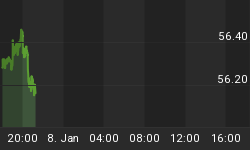What could have told you that the market would drop after September 16th?
Today, we will post two charts ... one chart of the S&P 500 Index, and a second chart showing what has been happening to S&P stocks on an UnWeighted basis.
First ... is the daily chart of the S&P 500 Index showing the September 8th. to October 4th. time period. Note how the S&P 500 went up from September 9th. to September 16 when it reached a peak and moved back down straight into October. See the next chart ...

This second chart shows the results of our nightly run on 500 UnWeighted S&P stocks relative to "how many have Negative Strength versus how many have Positive Strength". (This chart is shown on our Standard subscriber site each day in Section 4, as Chart 1.)
*** This analysis is a simple analysis because you don't have to be a rocket scientist to understand what it is saying about the market. In basic terms ...
If the (blue line) number of Positive Strength stocks is greater than the number of Negative Strength stocks (red line), then the Bulls would have the dominant power and the market bias would be to the upside. Since we are measuring 500 stocks, above the 250 level would be the half-way Equilibrium point for which you would also want to see the number of Positive stocks to be above that level. (The higher the amount over that level, the stronger the Bulls are.)
If on the other hand, the number of Negative Strength stocks is above 250 and greater than the number of Positive Strength stocks, then the Bears would have the dominant power and the market bias would be to the downside
So, let's now compare the time period in the two charts. Chart one shows that the S&P moved up from September 9th. to September 16th. Chart two shows why that happened ... it is because the number of Negative stocks decreased every day until September 16th. when it then reversed and started increasing with the very next trading day showing more Negative Strength stocks than Positive Strength stocks. That said that the dominant power had shifted from the Bulls to the Bears.
After September 16th, chart one shows that the S&P continued to move in a down trend. The reason WHY it moved down since September 16th. is seen in the second chart below.
What's the reason? It is because the number of Negative Stocks were greater than the Equilibrium number of 250, greater than the number of Positive Stocks, and because the Negative Stocks were also trending higher since that September 16th. date.
Think about it ... how could the market move up higher if the number Negative Strength stocks were outnumbering the number of Positive Strength stocks? ... and how could the market move up if the Negative Strength stocks were also increasing in numbers as time went on?

















